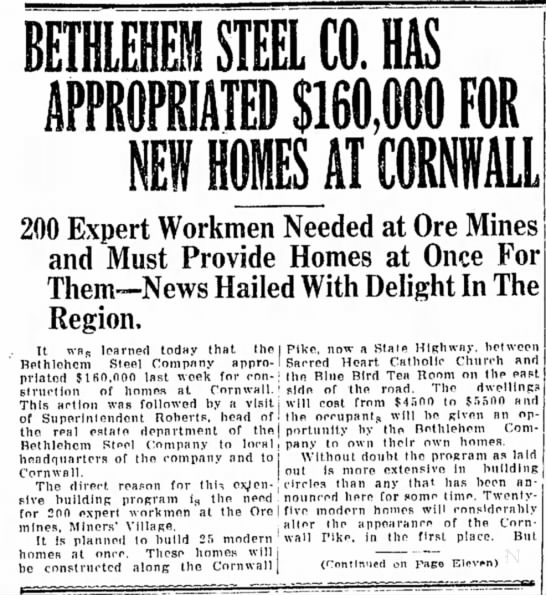Among the handful of Cornwall villages that developed while work in the Iron Banks flourished, Toytown, as it is commonly known, was built in quite a different way.
Located on Cornwall Road between the Bluebird Inn and the Sacred Heart of Jesus Church, Toytown, officially a part of the Cornwall Commons project, was a construction project paid for by the Bethlehem Steel Company (BSC) for employees working at the Iron Banks. Work began on its construction in 1926 and was finished over the course of a year.

Why the name Toytown? In contrast to the sturdy, stout stone houses of other Cornwall villages, Toytown’s structures were small and wooden. Toytown was also the first Cornwall community to be built with indoor bathroom facilities, a feature made possible by BSC’s newly-constructed water line in the area. To do this, BSC formed a water company and began the process of bringing piped water to the area, with Toytown being the first to receive bathrooms that did not stand outdoors as outhouses.

The 25 original Toytown homes were supplied and constructed by the West Virginia-based Minder Home Corp. in 1926. The materials for each house were packed into rail cars and shipped up to the site, one house per car, according to one resident. After cellars and other preparations were made for the homes, a group of Minder Home Corp. contractors traveled into town and erected the frames. The roofs, furnaces, and fireplaces were constructed and the row of homes was complete.
The name “Cornwall Commons” generally referred to the area surrounding the Cornwall Elementary School, including Toytown. Over time, this designation has been overtaken by the similar “Cornwall Center.”
Toytown’s plumbing served as a model for other Cornwall villages, which would eventually be given services of their own. There were more managerial types living in Toytown than in other Cornwall villages, which housed the physical laborers and miners.

As the years wore on and BSC’s operating costs began to overtake its profits, it sold Toytown houses to their current residents in 1957. Previously, it had cost as little as $18 to rent for Cornwall workers, although this rent went up as decades passed.
The Toytown of today now encompasses a few other lanes in addition to Pine Street, including Juniper, Maple, Spruce, and Cedar. Though it hardly seems that the now comparatively-average houses would still be considered ‘toys’, the atmosphere of the little town has become quaint, quiet, and homey. Trees have grown back in – it is no longer the necessary side product of a mining operation but instead its own place, with its own unique history.


































